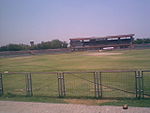Badkhal Lake

Badkhal Lake is a natural lake situated in Badkhal village near Faridabad, in the Indian state of Haryana, about 32 kilometers from the national capital of Delhi. Fringed by the hills of the Aravalli Range, this was a man-made embankment. Owing to unchecked mining in neighbouring areas, the lake began drying up two decades back and is now totally dried up. There are functional Haryana Tourism Corporation restaurants in the vicinity. A flower show is held every spring here. Its name is most probably derived from the Persian word beydakhal, which means free from interference. Close to Badkhal Lake is the Peacock Lake. It is a biodiversity area within the Northern Aravalli leopard wildlife corridor stretching from Sariska Tiger Reserve to Delhi. Historical places around the lake include the 10th century ancient Surajkund reservoir (15 km north) and Anangpur Dam (16 km north), the similarly dried up Damdama Lake, Tughlaqabad Fort, Adilabad ruins and the Chhatarpur Temple. There are several dozen lakes formed in the abandoned open pit mines in and around the sanctuary. It is contiguous to the seasonal waterfalls in Pali-Dhuaj-Kot villages of Faridabad, the sacred Mangar Bani hill forest and the Asola Bhatti Wildlife Sanctuary.
Excerpt from the Wikipedia article Badkhal Lake (License: CC BY-SA 3.0, Authors, Images).Badkhal Lake
Geographical coordinates (GPS) Address Nearby Places Show on map
Geographical coordinates (GPS)
| Latitude | Longitude |
|---|---|
| N 28.415 ° | E 77.276 ° |
Address
121001
Haryana, India
Open on Google Maps






